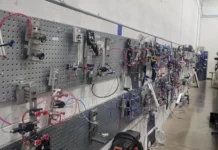by Jim Zinski, Novatec
Increasing profits, satisfying customer demand and improving utilization of production floor space are all strong reasons to consider a new central resin conveying system.
But what does that really mean?
In basic terms, we’re talking about automating the resin handling process. This includes getting the buckets, ladders, pallets, bags, manpower and brooms out of the manufacturing process and replacing those with efficient, automatic moving and loading devices. The benefits? Reduced waste, manpower and injuries, which translates into improved part quality, space savings and increased production and response time. In other words… INCREASING YOUR “UP-TIME” AND REDUCING YOUR COSTS TO IMPROVE YOUR PROFITS AND YOUR COMPETITIVE POSITION IN THE MARKETPLACE.
Each time you add a piece of equipment that automatically moves resin from a container to a dryer, blender, process machine or granulator you are taking a positive and productive step in the direction of true automation.
Even the smallest processors benefit from adding basic automated machines such as vacuum loaders or air loaders with self-contained controls to remove resin from a Gaylord (bulk boxes). Conversely, compressed air loaders are limited in the amount of material they can transfer and the distance over which they can move material. Typically they can transfer up to 500 lb./hr. over a distance of about 15 feet. Vacuum loaders (sometimes called “motor loaders”) are available in a wide variety of styles with capacities from 0.2 ft.3 to 1 ft.3. Loaders with brush-type motors usually can transfer up to about 650 lb./hr., and loaders with brushless motors can transfer almost double the throughputs of the brushed-type motors.
These solutions are an improvement over the bucket brigade, but vacuum loaders are high energy users, and loaders with brushed motors require extra labor to replace brushes and motors. On top of that, the production floor is still clogged with large containers of resin and the forklifts to move them on and off the floor. So anyone using multiple vacuum loaders as their primary way of transferring material should recognize that this is definitely a step in the right direction, but also should consider upgrading to a central conveying system for maximum efficiency.
A central resin handling conveying system eliminates individual vacuum loaders and relies on a central vacuum source, such as positive displacement pumps or vacuum regeneration blowers. These central vacuum pumps create the suction to pull materials from their sources to vacuum receivers that are located on drying hoppers and then to machine mount JIT receivers that are mounted directly on the machine throat.
Benefits to the small- to medium-sized processors include an integrated resin handling system, which gets material containers off the production floor and reduces energy and direct labor costs. There are simple PLC controls that operate a single vacuum pump and up to about six vacuum receivers, as well as controls that can operate multiple pumps and well over 100 vacuum receivers.
Large processors have infinitely greater options and benefits. Bags, barrels and Gaylords of primary resins can be eliminated in favor of bulk deliveries by truck or railcar. Bulk unloading systems can be used to transport resin to outdoor silos or to indoor bulk storage bins away from the production floor. Another benefit of central conveying is being able to ensure that materials are going from the desired source to the desired destination through some type of manifold system. Resins that are used in smaller quantities may still be drawn from bulk boxes but, instead of clogging the production floor, the material containers are in a central storage area – often under a mezzanine that holds central dryers and drying hoppers.
Central drying systems are typically an integral part of a central conveying system, but that is part of another conversation.
Jim Zinski is vice president, system design at Novatec, Inc. He has over 20 years experience in designing and installing plastics conveying systems. He has degrees from the University of Pittsburgh and Carnegie Mellon University. He brings a combination of engineering expertise, business knowledge and practical experience to plastics processors. He can be reached at 443.844.6507. For more information, visit www.ptonline.com.




